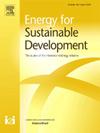Energy requirements for sustainable human development
IF 4.4
2区 工程技术
Q2 ENERGY & FUELS
引用次数: 0
Abstract
In this paper, we explore the relationship between sustainable energy consumption and human well-being. We estimate energy sufficiency levels for achieving Equitable Development Levels (EDL) using the quadratic plateau (QP) model for fourteen development variables related to health, education, and infrastructure for the period between 1990 and 2017. Our results show that the energy threshold necessary for securing key developmental targets is 70 GJ person−1 year−1. Even after accounting for the changing energy-development relationship due to improvements in technology, efficiency, scales of production etc., we find that primary energy supply for meeting developmental needs is likely to be in the range of 75 to100 GJ person−1 year−1, in 2050. Our analysis shows that estimates of “decent living standards” in the existing literature, are highly inadequate and do not address the developmental needs and aspirations of the global South.
求助全文
约1分钟内获得全文
求助全文
来源期刊

Energy for Sustainable Development
ENERGY & FUELS-ENERGY & FUELS
CiteScore
8.10
自引率
9.10%
发文量
187
审稿时长
6-12 weeks
期刊介绍:
Published on behalf of the International Energy Initiative, Energy for Sustainable Development is the journal for decision makers, managers, consultants, policy makers, planners and researchers in both government and non-government organizations. It publishes original research and reviews about energy in developing countries, sustainable development, energy resources, technologies, policies and interactions.
 求助内容:
求助内容: 应助结果提醒方式:
应助结果提醒方式:


